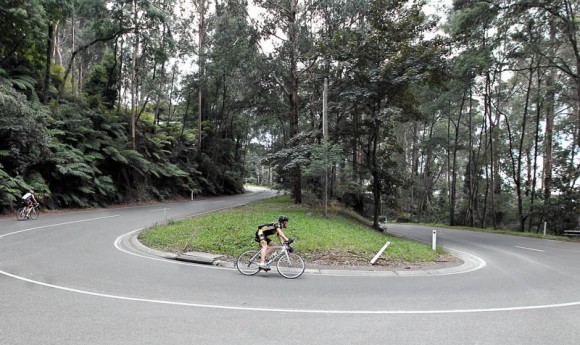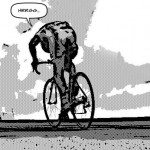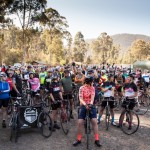UPDATE: Joel has won the Delirium 24-hour race, amassing an incredible 743.7km in a touch under 24 hours. Not only did Joel win the event, he smashed the previous Delirium record by nearly 100km. Congratulations Joel on a truly inspirational effort!
Avid readers of this site will remember Joel Nicholson’s guest post from a few months back in which he wrote of the 1,200km ride he did in three days. This weekend, Joel flies to Western Australia for the Delirium 24-hour race which is held on a 3.7km circuit near Margaret River.
I caught up with Joel in the lead-up to his trip to find out how he got into super-long-distance riding and what he’s hoping to get out of Delirium this weekend.
What made you want to do such long rides?
I first got involved with Audax in January last year after doing the very enjoyable and achievable two-day Alpine Raid, an event that I was using as recon and training for the 3 Peaks Challenge. During the course of the weekend, I picked up an Audax ride calendar somewhere and started to flick through it.
I realised that there were a lot of rides available and that some of them could be used to compliment my training. So I picked one that I thought would be interesting; a 200km night ride along Beach Road, called “The Salute to Irene Plowman”. This ride turned out to be heaps of fun, despite my totally inadequate lights, with a great atmosphere and amazing support at each of the checkpoints.
After the 3 Peaks Challenge, I was a little lost and looking for something to help maintain my fitness through the colder months so I entered and completed a 400km Audax ride in South Gippsland. This was a more typical Audax event, low-key with a small field, but all the old-hands were very welcoming and, once again, the support was great (a home-cooked meal at every checkpoint!). From this point on I was hooked.
One of the main appeals of cycling is the challenge of pushing your own limits, in most cases that means riding faster or climbing bigger mountains. But I find the challenge in riding longer distances because there is really no upper limit to how far you can ride and so no upper limit to how much you can challenge yourself. I mean, you can only ride so fast and mountains only get so high, but the road just keeps going forever …
What are some of the long-distance rides you’ve done since getting involved in Audax events?

During the last year or so, I have done about 25 Audax rides, logging around 9,000km, including five 200km, five 300km, a 360km, three 400km, five 600km and a 1200km ride. Some of the standout rides include a couple of tough 200km mixed-terrain rides in the Strzelecki Ranges, a horrendously windy and wet 600km from Geelong to Warnambool and back along the Great Ocean Road and, of course, the 1200km Great Southern Randonnee.
What’s the motivating factor when you sign up for a ride like the Delirium 24-hour race, or the Great Southern Randonee?
Signing up for longer and longer rides is a insidious step-wise process. You start off small with a 200km ride, then a 300km ride, then a 400km ride and so on, until, before you know it, these really long rides are within your grasp and in a fit of madness you sign up for them as well. Unlike racing, where much of the challenge comes from competing against others, long-distance riding is a personal challenge, so you have to keep finding ways to push your own limits, either through longer/harder rides or by attempting to complete seasonal objectives.
What’s the lowest point you’ve had on the bike during one of these super-endurance events?
One of the most interesting things I have found about long-distance riding is how many physical and psychological ups-and-downs you can have over the course of a long ride. Normally it is just the little things that usually annoy cyclists that make you feel down — a headwind, an annoying squeak from the bike, a bit of a hunger flat — they make you question what you are doing and why. Conversely, a nice tailwind or a handful of lollies can make you inordinately happy and the kilometres just fly by.
Once you get used to the cyclical nature of your mood and condition on the bike, you realise that you will generally ride out of the low point before too long. Audax rides are non-competitive so you can afford to take it easy while you are feeling down and perhaps pick up some time later on, when your mood and condition are a little better.
One of the lowest points on any ride I have had was during my first 600km ride, Geelong to Warrnambool and back, with an overnight stop in Port Campbell. A small group started off in Geelong with a brisk headwind but we were fairly sheltered by the coast until we reached Apollo Bay and started to climb the Otway Ranges.
By this point I was on my own and each time I reached the top of a climb, I was smacked in the face with a gale-force blast of wind and once out in the open, there was no let-up from the wind at all. It was dark and the last few kilometres into Warrnambool seemed to take forever. At one point I looked down at my computer, saw that I had 20km to go until Warrnambool and that I was travelling at 20km/h, so I knew I only had an hour of riding until the turnaround.
A while later, I looked down and saw that I only had 17km to go but by then I was only travelling at 17km/h, so I still had an hour of riding in front of me. This went on for some time and I still reckon that “last hour” into Warrnambool really took about two hours that night.

How do you get yourself out of low points like that? How hard is it to keep going when it feels so hard?
This is a surprisingly common question. Everyone asks me how I keep going when it gets tough. I think they expect me to say something about mental toughness and internal fortitude but really it’s just a combination of dumb pride and plain logistics – my car is usually parked somewhere in a town a hundred kilometres away and it is simpler and far less embarrassing just to suck it up and keep riding than it is to call it quits and sit on the side of the road for a few hours until help arrives.
How would you rate the mental challenge of these rides, compared to the physical challenge? Or to put it another way, how do you keep yourself sane on the bike for 24 hours?!
For the most part, Audax rides are not as physically demanding as they appear on paper. They may be very long but they also have fairly relaxed time limits, so the riders can really ride at their own pace the whole time. This means that if you are having a tough time, you can stop at the next checkpoint, have a coffee, a decent meal or maybe even a nap without endangering your chances of finishing the ride in time.
In most instances, however, I have my own personal time goals that I have set and this greatly increases the mental challenge of the ride, because I generally have a very strict schedule to maintain. This is especially relevant on multiday rides because it’s mentally very difficult to ride all day, sleep for a couple of hours then wake up and do it all over again the next day, all while sticking to a set schedule.
I am often asked how I amuse myself/stay sane during my long rides and, to be honest, I’m not sure that I do stay sane! I rarely listen to music, so I have a lot of empty hours to myself and generally end up talking to myself while doing long calculations in my head , trying to work out what percentage of the total distance I have ridden, down to two decimal places.
I actually find it very relaxing and I enjoy the chance just to think without any distractions. I mean, how often do you get to spend several hours on your own without phones, Facebook or TV, all while enjoying the scenery of rural Australia?
What’s your goal for the Delirium 24-hour race this weekend?
Delirium is so far outside of my current experience that I’m not sure what to expect from myself, but I am hoping to be able to ride at least 600km during the 24 hours. Previous experience suggests that 600km+ is certainly achievable (if painful), so it is matter of preparing well and just hoping that it all comes together on the day.
What’s next after that? Do you have an ultimate goal you’d like to achieve as a super-long-distance cyclist?
I do have my eye set on a couple of long Audax rides in the coming season: a 1000km ride from Adelaide to Geelong at the end of April and Sydney-Melbourne (1200km) in November.
As far as endurance racing is concerned, I will have to see how I find Delirium, but there are very few endurance road races on offer in Australia so I may have to make to switch to mountain bike if I want to compete in more 12/24-hour races.
There is one event that captured my imagination even before I got into long-distance cycling, the Race Across America (RAAM), a 4,800km non-stop race from the west coast to the east coast of the US. There is a 12 day time limit, but the winners typically complete the distance in 8 or 9 days on only a few hours sleep. This is perhaps the pinnacle of endurance cycling and probably beyond my abilities, but it doesn’t hurt to dream …
What advice would you have for anyone that’s looking to get into super-long-distance riding?
My advice to any budding long-distance cyclists is to start small, be it 50km, 100km, 200km, etc and slowly increase the distance. In my opinion, once you can ride 400km you can ride any distance. The Audax calendar is full of rides, especially during Spring/Autumn and all comers are welcomed.
On long rides, try to eat real food because gels and bars are pretty unappealing after 10 hours on the bike. Most of my rides are powered by lolly snakes, potato cakes and cinnamon doughnuts. Experiment with different sports drinks, because maintaining your electrolytes is extremely important.
The choice of clothing is always a difficult decision, because you are likely to encounter a huge range of conditions — the cold of the morning, midday warmth, a late afternoon shower and a chilly night. Invest in a decent rain jacket and always carry it with you, use warmers to protect your joints, especially the knees.

Never go on a long ride using untested equipment — those knicks or gloves that are comfortable on a 100km ride may turn out to be torture devices on a 300km ride. A bit of chafing can quickly turn into a raw patch the size of a 50c coin or a painful blister. My trick is to use gear that is worn-in but not worn-out.
If you spend money on anything, make sure it is on lights — good lights are required by Audax rules and essential for safe riding in the dark. And believe me, it can be very, very dark on a small country road way out in the backblocks at 2am!
Above all, learn to pace yourself. This is hard because you aren’t just pacing yourself for a couple of hours, you are pacing yourself for half a day, a day or even several days. Running out of steam 30km from the finish of a ride is bad enough, imagine doing it 200km from home …
If you have a specific time goal set for a ride, I find it useful to schedule the whole ride. Pick a reasonable average speed, plan when you are going to reach each checkpoint, how long you will stay there and when you will leave. This takes care of all the thinking before the event and, once on the ride, try to stick as closely to this plan as possible, because any decisions you make on the road at midnight after 18 hours of riding will probably not be terribly well thought out.
Most Audax rides up to 400km can be reasonably completed without sleep, while all rides over that distance allow for sleep stops. I have done a 600km ride without sleep, and wouldn’t recommend it, so I suggest that you take advantage of whatever accommodation options are on offer, even if it is only for a couple of hours. For the really long rides (1000km+) over several days, I think sleep can be the hardest thing to plan, because you need to decide where and when to sleep and you want to get enough sleep to function properly but don’t want to lose too much time.
In terms of injuries and strains, cycling is a low-impact sport so the level of wear-and-tear is fairly low. But, with long-distance cycling there is a certain amount of strain that comes from the tens of thousands of pedal revolutions and from sitting in the same position for many hours. I have been fairly lucky so far and have not developed any serious cycling-related conditions, but I do occasionally suffer from a sore back/shoulders, slight hot-foot and from numb hands. Most issues can be prevented/treated by using the correct gear and by having a good position on the bike.
***
Thanks very much to Joel for taking the time to answer my questions. I wish him all the very best of luck for this weekend’s Delirium 24-hour race and look forward to hearing how it went.








Now I see why Joel didn’t tear our legs off on the 400km audax out of Bendigo last weekend. A 400km, followed by a 24 hour mountain bike race, followed only a few days later by a 1000km ride.. incredible.
Great article. Good luck Joel!
Delirium sounds incredibly tough. I’m glad it is you and not me.
I’ve never done an Audax ride longer than 200km. Distances greater than this are beyond me right now. I respect and admire those who are able to complete the longer rides.
I agree wholeheartedly with Joel about Audax food. At the finish of a recent 200km Audax ride, I ate a slice of carrot cake, a slice of chocolate cake, a piece of sticky date pudding, a chocolate brownie, an ANZAC biscuit, a burnt butter biscuit, a melting moment, a chocolate crackle and a honey joy. All of these wonderful cakes were homemade and provided by the ride volunteers. Utterly magnificent food.
Enjoy the Delirium.
Tell us how the airlines treated you in relation to bike transport.
Is the Paris-Brest-Paris on your bucket list in 2015?
Goodluck joel!